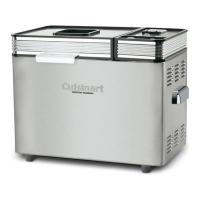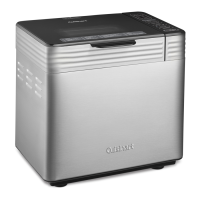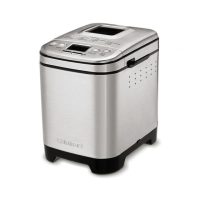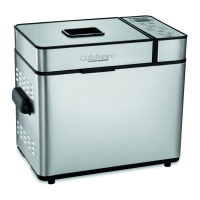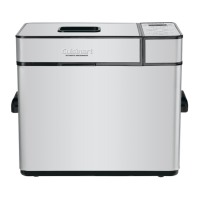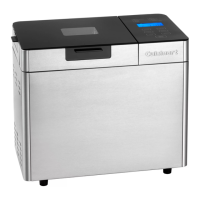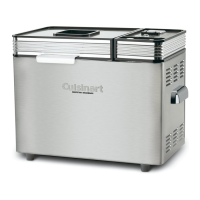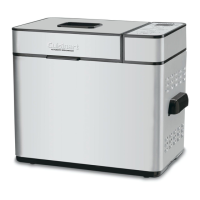16
and help it to grow better.
Too much cinnamon or garlic can counteract the rising properties of
yeast. Also in this category of “yeast destroyers” are too much citrus
zest and alcohol.
Always add nuts at the Mix-in signal. Adding them too early may
result in their becoming too nely ground.
TROUBLESHOOTING
Dough Does Not Rise Properly – Check expiration date of yeast.
Make certain yeast is fresh and properly stored (sealed, in a cool dark
place).
Liquid may have been too hot and killed yeast or liquid may have
been too cool and yeast did not activate completely – liquids should
be between 75 – 90°F (24 – 32°C) for best bread machine results.
Delay Start feature used, but ingredients were in bread pan in im-
proper order. See page 13.
Short loaves – Not enough sugar in recipe.
Not enough yeast. Yeast was old or improperly stored.
Delay Start feature used and ingredients not placed in bread pan
properly. Salt came into contact with yeast and killed yeast.
Loaves with whole wheat and/or whole grain ours will not be as tall
as those made with bread our.
Sunken, uneven tops of loaves – High humidity or high room
temperature. Do not place bread machine in sunny window.
On high humidity days, try increasing the our by one tablespoon
(15 ml) per cup (250 ml) of our used.
Underbaked, gummy texture – Dough too wet. When baking next
loaf of same bread, watch dough and add our 1–2 teaspoons
(5–10 ml) at a time.
Too much whole grain or whole grain our used.
Bread pan too small for recipe.
Collapsed loaf – Dough too wet. When baking next loaf of same
bread, watch dough and add our 1–2 teaspoons (5–10 ml) at a time.
Water not proper temperature.
Ingredients not in proper proportions – be sure to measure dry
ingredients correctly by stirring ours rst, spooning into measuring
cup, then leveling.
Open texture – Dough too wet. When baking next loaf of same bread,
watch dough and add our 1–2 teaspoons (5–10 ml) at a time.
Too much yeast was used.
Salt was omitted or incorrectly under measured.
Dense, heavy texture –
Dough too dry. When baking next loaf of
same bread, watch dough consistency and add water/liquid 1 tea-
spoon (5 ml) at a time.
This may occur when substituting lowfat products such as fat-free
milk or egg replacers, light butter or margarine, fat-free sour cream or
cream cheese.
Not enough sugar in recipe.
Not enough yeast used. May need to add dough enhancer or vital
gluten our.
Kneading paddle embedded in the loaf – If you are nearby when the
signal before last rise sounds, you can remove the kneading paddle,
reshape the loaf and replace.
Small amount of smoke/burning smell from machine – Most often
this is caused by spilled ingredients. If it is bad, unplug machine,
clean carefully (Caution: interior of machine is hot), then plug
machine in again to continue. Program will be stored in memory for a
maximum of 15 minutes if unplugged. Otherwise “our dust” will burn
off on its own. Clean completely when machine is unplugged and
cool.
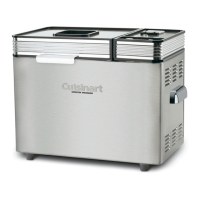
